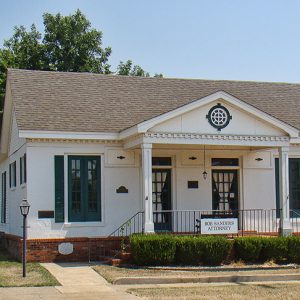calsfoundation@cals.org
Flanagin Law Office
The Flanagin Law Office is located at 320 Clay Street in Arkadelphia (Clark County), across the street from the Clark County Courthouse. The building was finished by 1858 and added to the National Register of Historic Places on December 22, 1977.
The office is named for Harris Flanagin, governor of Arkansas from 1862 to 1864. A New Jersey native, Flanagin moved to Arkansas from Illinois. Settling in the Clark County seat of Greenville, Flanagin moved to Arkadelphia when it became the county seat in 1842. The same year, he was elected to the Arkansas House of Representatives, and in 1848 he was elected to the Arkansas Senate. In 1851, he married Martha Nash of Washington (Hempstead County). Sometime in that decade, he began practicing law with J. L. Witherspoon. Both men joined the Confederate army at the outbreak of the Civil War. Witherspoon served as a recruiting officer, while Flanagin joined the Second Arkansas Mounted Rifles. After service at the Battles of Wilson’s Creek and Pea Ridge, the unit moved east of the Mississippi River with the majority of Confederate forces in Arkansas. While in Mississippi, the unit underwent a reorganization, and Flanagin was elected colonel of the regiment. He held that post until he was notified in October 1862 that he had been elected governor of Arkansas. Resigning his position with the army, he returned to Arkansas to begin his term.
The building was constructed in several phases. The front portion was constructed by Witherspoon. J. H. O’Baugh, a local brick maker, provided the bricks for the first phase of construction and possibly built the office. The bricks were received in 1855, and the construction of the building was finished by 1858. The original design of the building was two rooms with a front porch. Each room had a single door that opened onto the porch, but the rooms were not connected by a passageway. Each room also contained a fireplace and chimney. The interior of the building was covered in lathing.
At the end of the war, both Flanagin and Witherspoon returned to Clark County and resumed their law practice. Sometime during this period, Flanagin purchased the office from Witherspoon. In 1874, Flanagin was selected to represent Clark County at a constitutional convention but became ill during the proceedings, dying in Arkadelphia on October 23.
After Flanagin’s death, the office passed to his son Duncan. A section of rooms constructed from wood was added to the rear of the property, and a door connecting the two original rooms was installed. The property was rented as private housing until 1903, when Duncan Flanagin sold the building to Judge J. H. Crawford, who used the building as a law office until his death in 1930. At that time, his son Dwight Crawford acquired the building and used it as a law office until his death in 1968. The office remained in the family and was rented to Judge Earnest Still. In 1974, the office was sold to Robert Sanders, another local judge, who continued his ownership of the property into the twenty-first century.
The building rests on a brick foundation and is topped with an asphalt roof. Facing south, the office is accessible through the original front doors from a small brick porch. The doors are each topped with a single paned transom. A triangular portico is above the porch and is supported by two columns. Detailed woodwork appears on the columns and top of the porch. Two French-style windows are also located on the front of the building, each containing two five-by-two panels. Two windows are present on the west side of the building but were covered at an unknown date. The wooden addition includes a modern window and door on the west side and a window on the east side.
For additional information:
“Flanagin Law Office.” National Register of Historic Places registration form. On file at Arkansas Historic Preservation Program, Little Rock, Arkansas. Online at https://www.arkansasheritage.com/arkansas-historic-preservation-program (accessed November 15, 2024).
Richter, Wendy, et al. Clark County Arkansas: Past and Present. Arkadelphia, AR: Clark County Historical Association, 1992.
David Sesser
Henderson State University







Comments
No comments on this entry yet.